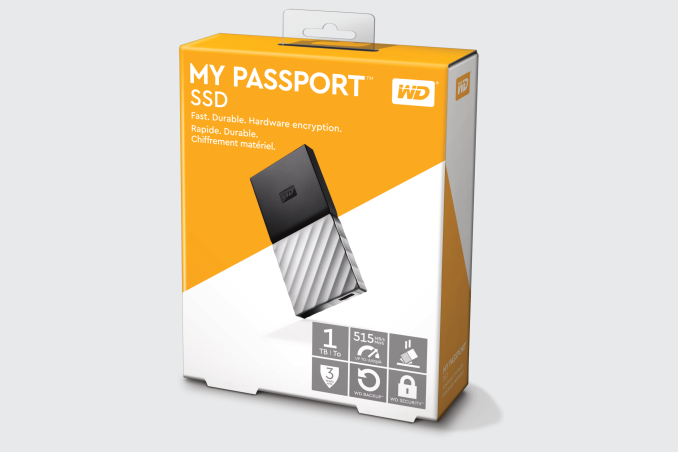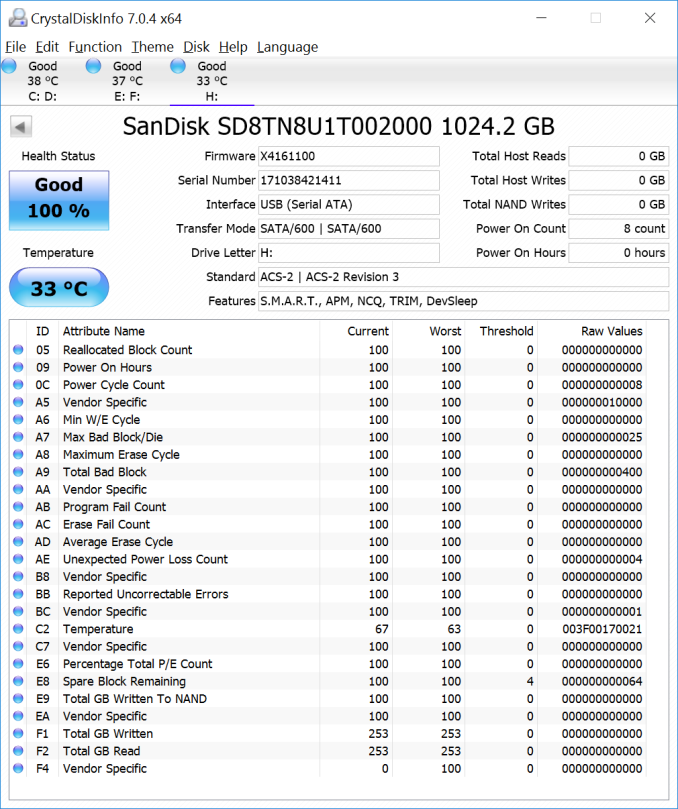Western Digital My Passport SSD Mini-Review
by Ganesh T S on June 28, 2017 8:00 AM EST- Posted in
- Storage
- SSDs
- Western Digital
- DAS
- USB 3.1

Flash-based external direct-attached storage (DAS) devices have evolved rapidly over the last few years. Starting with simple thumb drives that could barely saturate USB 2.0 bandwidth, we now see high-performance external SSDs. Western Digital's My Passport SSD is an external SSD with a USB 3.1 Gen 2 Type-C interface. It comes in three capacities - 256GB, 512GB, and 1TB. Catering to the mainstream market, it is currently a Best Buy exclusive. This review takes a look at the 1TB variant of the My Passport SSD.
Introduction and Product Impressions
Over the last five years, Western Digital (WD) has made a string of acquisitions as part of the overall consolidation trend in the storage market. The two key ones have been HGST and SanDisk. Though there has been a bit of overlap in terms of product lines (such as flash-based DAS units that were sold by both G-Technology / HGST and SanDisk), WD has managed to streamline their lineup - different brand names now cater to different market segments. Taking the case of the external SSD market, we have G-Technology catering to the content creation crowd with products such as the G-DRIVE slim SSD USB-C. SanDisk now concentrates on the enthusiast / power user market with products such as the Extreme 900. This leaves the mainstream market to the Western Digital brand. We have already seen the WD brand getting used for mainstream SSDs, and, it is now time for the same to happen in the external SSD market. The My Passport SSD is an external SSD with a USB 3.1 Gen 2 Type-C interface. It comes in three capacities - 256GB, 512GB, and 1TB. It is currently a Best Buy exclusive.
The dimensions of 45mm x 90mm x 10mm point to the use of a M.2 SSD inside the product. WD also advertises hardware encryption for better security. The contemporary industrial design is compact and attractive. The product is bus-powered. Hence, the supplied material in the package is minimal. In order to ensure wider compatibility, WD also supplies a small Type-C to Type-A adapter along with the Type-C to Type-C cable. Other than that, we have the usual warranty papers and quick start guide.
The drive comes pre-formatted in exFAT, and also has a number of software installers to enhance the utility of the product - WD Discovery & Drive Utilities, WD Backup (Windows only), and WD Security. The WD Backup software can be used to create scheduled backups of certain folders on the PC to the SSD. WD Security allows the setting of a password (up to 25 characters) that activates the hardware encryption features on the drive. The drive needs to be unlocked with the password upon system restart, or drive reconnect, or exit of the system from sleep mode.
Like the G-DRIVE slim SSD USB-C, the WD My Passport SSD is also based on the SanDisk X400 launched in early 2016. It is a TLC-based SSD sporting the Marvell 88SS1074 SSD controller. We infer this from the CrystalDiskInfo information.
While the X400 in the G-DRIVE slim SSD USB-C was a retail 2.5" model, the SSD model number SD8TN8U-1T00-2000 points to a OEM M.2 SATA model with self-encryption capabilities enabled.
The enclosure proved to be a tough one to take apart, and we were unable to determine the SATA - USB bridge chip being used. However, all the SanDisk external SSDs we have evaluated so far have come with ASMedia bridge chips. Based on that, we think it is likely that the My Passport SSD uses the ASMedia ASM1351 SATA to USB 3.1 Gen 2 bridge along with the ASMedia ASM1543 Type-C switch (same as the G-DRIVE slim SSD USB-C).












22 Comments
View All Comments
Huacanacha - Wednesday, June 28, 2017 - link
That wouldn't make sense as data already on the drive would need to be re-encrypted. Much more likely it's just a simple password that, if set, is required to enable the controller to use the hardcoded key.edzieba - Thursday, June 29, 2017 - link
It's not a 'hard coded' key, just a randomly generated one at initialization. One key is used to encrypt the partition that stores block allocations, and another that encrypts blocks on write. Because the blocks need to be manipulated and encoded before write anyway (to minimise sillyness like all bits in a block being '1') encrypting it at the same time is close to 'free'. Encrypting also gives a nicely high-entropy output so can substitute another stage intended to give high entropy data.This is why a the "SSDs don't really delete your data!!!1" stores are a bit of bunk: If you grab the raw NAND chips and read them back, you get a randomly arranged assembly of blocks of encrypted data. Deleted or not, you're not recovering anything without the key.
edzieba - Thursday, June 29, 2017 - link
Whoops, didn't mean to hit submit yet. The passcode you enter in the drive is just to lock drive controller, and acts similarly to the ATA password of old in that without it the drive controller won't do what you tell it to (and the drive controller holds the actual keys).VulkanMan - Thursday, June 29, 2017 - link
It IS hard coded, you can't change the encryption key on the device.It is set at the factory, and yes, it is randomly generated (well, so we think).
Bullwinkle J Moose - Thursday, June 29, 2017 - link
Wish you had a Corsair GTX in there for comparison instead of the GSI'd rather see only "Bootable" USB drives with Trim/GC compared
A direct comparison of Windows Boot Times and a 100GB copy/paste from and to the same SSD to test internal throughput would tell me everything I need to know
Synthetic tests have no place in the real world!
mr_tawan - Thursday, June 29, 2017 - link
I'd love to see the Passport Wireless version of this. While I'm not certain if it would improve the battery life, I think it could withstand physically abuse better than the mechanical drive. Portable devices should move to Flash storage instead of keep using mechnical drive.jaydee - Thursday, June 29, 2017 - link
"Catering to the mainstream market, it is currently a Best Buy exclusive."Catering to the mainstream market and NOT available on Amazon? Really?
jhoff80 - Thursday, June 29, 2017 - link
Maybe I'm wrong, but I was under the impression that a USB-A male to USB-C female adapter was very much forbidden by the USB-C spec.BMNify - Thursday, June 29, 2017 - link
Anyone can compare this and the ADATA SE730?Belard - Sunday, July 9, 2017 - link
Hmmm... the WD is easily on the bottom end for performance. The thermal throttling should be a concern as that seems to be a major cause for its performance loss.Either the M2 they built is not well done or the VERY nice external case (which is the same style as their external HDD-drives) doesn't remove heat from the M2 SSD. Looking at the other units, even the G-drive run a lot cooler, with Samsung among the coolest.
What is there to recommend on this product, other than its looks? It will sell well of course.